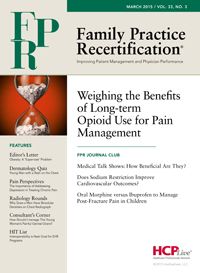Publication
Article
Family Practice Recertification
Obesity: A 'Super-size" Problem
Author(s):
Although the obesity epidemic in the United States seems to have reached a plateau over the past few years, the prevalence of obesity continues to be high with 30% of Americans classified as obese, defined as having a BMI of 30 kg/m2 or more, and an additional 30% overweight, with a BMI of 25 to 29.9 kg/m2.

Although the obesity epidemic in the United States seems to have reached a plateau over the past few years, the prevalence of obesity continues to be high with 30% of Americans classified as obese, defined as having a BMI of 30 kg/m2 or more, and an additional 30% overweight, with a BMI of 25 to 29.9 kg/m2.
This epidemic is largely a consequence of 2 trends: (1) excessive calorie consumption stemming from poor food choices, coupled with a proclivity to overeat and (2) a decline in physical activity and exercise. While multifactorial in origin, the former is fueled, at least in part, by growing dependence on a fast food industry notorious for exhorting customers to make their orders "king-size", "extra-large", "biggie" and "super-size".
Although obesity is a chronic condition, I have always been struck by the number of patients who come to the office hoping for a “quick fix.” Many inquire about the new round of “wonder” drugs for obesity which have recently become FDA-approved: the serotonin 2c receptor (5HT2c) agonist, lorcaserin (Belviq®), the fixed-dose combination product of phentermine and topiramate (Qsymia®); the fixed-dose combination of naltrexone and bupropion (Contrave®); and the GLP-1 receptor agonist, liraglutide (Victoza®).
You can imagine their surprise when I inform them that lorcaserin is a distant cousin of fenfluramine, of Fen-Phen fame, but without theknown link to heart valve disease. Qsymia® is a combination of an old anticonvulsant agent plus the “safer” half of Fen-Phen (i.e. phentermine) which is an isomer of methamphetamine. Contrave® is a combination product consisting of a drug used for addiction, coupled with an antidepressant also used for smoking cessation. Finally, liraglutide is a subcutaneous agent used to treat type 2 diabetes.
This surprise is exceeded only by their disappointment when I inform them that at best they might lose 8 to 10% of their initial body weight during the first year of use and that continuation of the agent beyond that point holds only the promise of possibly maintaining the achieved weight loss, as opposed to adding to it. The trifecta is complete when they learn that while bariatric surgery is the most effective intervention, it, too, is not without risk, and that both the long-term sustainability of the weight loss achieved and the potential risk of long-term complications still needs to be determined.
What about the recently FDA-approved vagal nerve blockade therapy? Although a recent randomized, sham-controlled trial* reported a statistically significant 9.2% of initial body weight loss compared to the control group, this amount of weight loss is not that much more than what can be achieved by an intensive lifestyle weight management program or pharmacologic therapy.
The importance of recognizing and treating obesity and its complications, such as diabetes, heart disease, and osteoarthritis, notwithstanding, the true key to the management of obesity lies in prevention.
As primary care physicians, it is incumbent on us that we do more to stem the tide in a country where two thirds of Americans are obese or overweight. Instead of operating in a reactive mode of trying to deal with obesity after the fact, we instead should strive to be more proactive in helping our patients achieve and maintain a more healthy body weight.
Although a variety of weight management programs are designed to help achieve this end, all are grounded in 3 basic principles— principles which should be imparted and fostered in patients before weight becomes an issue: (1) regular aerobic exercise, aiming for 5 to 7 sessions a week, 30 to 60 minutes per session, (2) a healthy diet grounded in sound nutritional principles and consumed in appropriately-sized portions with full knowledge and awareness of caloric and nutritional value, and (3) regular monitoring of weight with adjustment of exercise and diet, as appropriate, to achieve the desired goals.
The idiom, "an ounce of prevention is worth a pound of cure" rings particularly true when regarding obesity, as such a population-level preventative approach is required if our "super-sized" problem is ever to be cut down to size.
* Ikramuddin S, Blackstone RP, Brancatisano A, et al: Effect of reversible intermittent intra-abdominal vagal nerve blockade on morbid obesity. The ReCharge Randomized Clinical Trial. JAMA 2014;312(9):915-922





